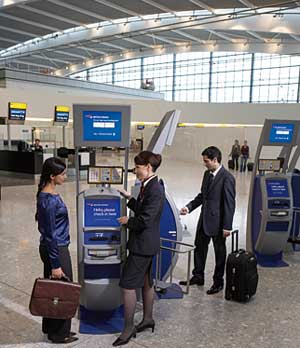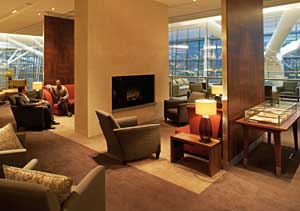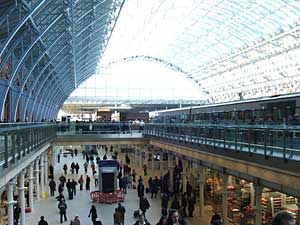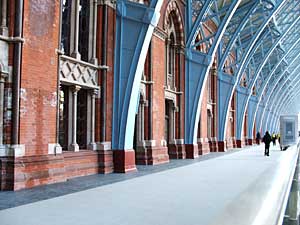Correction appended March 28, 2008
Heathrow Airport’s Terminal 5, designed by Rogers, Stirk, Harbour & Partners, officially opens tomorrow, providing air travellers with a more welcoming entry to London. It is the first new terminal at this airport, the world’s busiest, in more than two decades. But the building’s arrival comes amid growing concerns over Heathrow’s proposed future expansion plans—and a renewed appreciation of rail travel, embodied by St. Pancras International, which reopened last fall after an extensive refurbishment led by Rail Link Engineering and Ove Arup.




Photo © Jean Paul Froget (first two); James Murdock (last two).
Heathrow’s new $8.6 billion terminal, known as T5, promises to shorten queues for both domestic and international passengers. The 1,300-foot-long, five-floor building provides 96 self-service check-in kiosks and 140 customer service desks, as well as state-of-the-art baggage handling. It also offers the largest retail facilities of any UK airport—144 upscale shops and restaurants, totalling 200,000 square feet—and the world’s largest amount of airport lounge space, encompassing some 230,000 square feet.
Richard Rogers’s design features a 118-foot-wide “plaza” running the length of the building, which is glazed on all facades. This light and airy space contains the main transport links, check-in facilities, public artwork, trees, and even an outdoor café. The plaza, as well as terminal’s clear circulation scheme and the extensive passenger amenities, contribute to what Heathrow officials hope will be “a smoother, easier, calmer airport experience.”
The British Airport Authority (BAA), which manages Heathrow and the nation’s other airports, touts T5 as “one of the most environmentally friendly terminals in the world.” Sustainable strategies included careful material selection—such as the use of recycled concrete and formaldehyde-free interior wall board—and a water-use reduction program. Also, the need for artificial lighting was greatly reduced thanks to more than 465,000 square feet of glass walls and a transparent roof that together enable daylight to flood interior spaces.
But Britain’s environmental lobby has criticized the airport, as have residents who live near it. They’re concerned about BAA’s desire to build a sixth terminal and add a third runway. Such an expansion would involve demolishing nearby towns and relocating residents and, while it would grow Heathrow’s capacity by one-third—to more than 700,000 flights a year—it would also increase carbon emissions and noise pollution. More than 3,000 protestors turned out in February to rally against the scheme.
Despite such opposition, BAA will likely continue its bid to increase Britain’s short- and long-haul air travel. But transportation alternatives are also coming online. The St. Pancras International rail terminal, which opened in November, is creaming off air passenger trade to Europe with its high-speed Eurostar service. St. Pancras is better connected to Britain’s rail network than the former international terminal at Waterloo. (That facility, designed by Grimshaw Architects, will reopen in 2009 to serve railways in southeast England.) It also boasts travel times to Europe that are 20 minutes faster, thanks to a new dedicated tunnel under London, making Paris a less than two-hour journey. Touting the speed, greater reliability, and less environmentally damaging nature of rail travel, Eurostar is determined to outgun airline operators.
The $1.6 billion St. Pancras project included a mix of new construction and major refurbishment of the existing building, portions of which date to 1866 and are protected as a historic landmark. Its train shed, designed by Barlow and Ordish, once boasted the world’s widest span roof. This glazed volume, 450 feet long by 120 feet wide and 100 feet high, forms the building’s centerpiece. All the original ironwork was preserved, the number of platforms was doubled, and the Victorian Gothic-style ticketing halls were renovated.
Modelled after the refurbishment of Grand Central Terminal in New York City, St. Pancras is Europe’s first “Destination Station,” luring visitors to shop and dine regardless of whether or not they are travelling somewhere else. A new fully glazed retail concourse, based on a design concept by Foster + Partners, was added as a 160-foot-by-500-foot-long deck extension to the north of the train shed. It houses a total of 62 shops, a farmer’s market, and restaurants. Chapman Taylor and Arup Associates oversaw the fit-out of these spaces, many of which—including a 280-foot-long champagne bar, touted as the longest in Europe—feature views over the rail platforms.
Correction: Due to an editing error, the photo caption is incorrect. Heathrow T5 serves British Airways exclusively.




Post a comment to this article
Report Abusive Comment